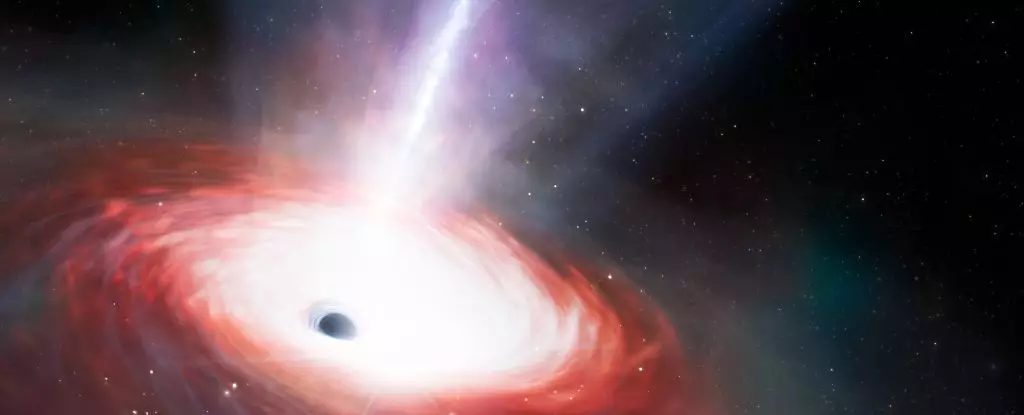In a remarkable astronomical finding, researchers have identified an exceptionally voracious supermassive black hole, located within the galaxy designated as LID-568. This celestial body, which existed only 1.5 billion years post-Big Bang, is consuming material at an astonishing rate—approximately 40 times beyond the so-called Eddington limit. This mind-boggling observation invites a reevaluation of black hole formation mechanisms in the early Universe, potentially shedding light on the origins of these colossal entities.
Astronomers have long grappled with the mystery of how supermassive black holes achieve their monumental sizes in such a brief timeframe after the Universe’s inception. As Julia Scharwächter from the Gemini Observatory notes, the unprecedented feeding rate of LID-568 suggests a possible explanation for the early emergence of massive black holes: a “fast-feeding” mechanism that surpasses known theoretical limits. This observation could reshape our understanding of black hole evolution during cosmological infancy.
The Eddington limit serves as a crucial threshold in astrophysics, dictating the maximum rate at which a black hole can accrete material without being countered by radiation pressure. When matter spirals into a black hole, it forms an accretion disk that spins vigorously, generating enormous friction and heating. The resulting luminosity produces a radiation pressure that balances the gravitational tug of the black hole; hence, exceeding this limit becomes a captivating question.
The phenomenon of super-Eddington accretion occurs when a black hole’s appetite overrides these constraints, enabling it to devour mass at an extraordinary pace. This scenario may help explain how primordial black holes, like LID-568, amassed their formidable mass so rapidly after the Big Bang. Such findings raise essential questions about the processes governing black holes and their environments in the early Universe.
Led by astronomer Hyewon Suh, a dedicated team of researchers utilized the James Webb Space Telescope (JWST) to conduct follow-up investigations of select galaxies previously identified by the Chandra X-ray Observatory. While many of these galaxies exhibited brightness in X-ray spectrums, LID-568 proved particularly elusive when it came to determining its distance and luminosity. Yet, the team’s utilization of the advanced integral field spectrograph on JWST’s NIRSpec instrument allowed them to pinpoint the galaxy’s coordinates precisely.
The results, while surprising, were fascinating. The faintness of LID-568 indicated a remarkable intrinsic brightness, suggesting that despite its cosmic distance, it must be generating enormous light output due to its feeding frenzy. Detailed spectral analysis revealed the presence of vigorous outflows from the black hole, a hallmark of high accretion activity.
When researchers assessed the mass of this supermassive black hole, they found it to be 7.2 million solar masses—a small figure in the grander context of black holes. However, the luminosity generated by the accretion disk far exceeded the expectations for a black hole of its size, indicating a dramatic 40-fold increase over the Eddington limit. Capturing such fleetingly dynamic accretion processes is a rare stroke of luck and gives scientists invaluable insights into the mechanics behind black hole growth.
This discovery has vast implications for our understanding of black holes and their formation. Traditional models suggested that black holes originated from the gravitational collapse of massive stars. However, evidence now hints at alternate pathways, such as the direct collapse of substantial gas clouds and stellar remnants. Such scenarios provide fertile ground for the rapid development of supermassive black holes.
The occurrence of super-Eddington accretion in LID-568 may point toward new theories or adaptations of existing models, fostering opportunities for further research. As scientists continue to monitor this unique galaxy, LID-568 is likely to become a keystone observational target, offering a window into the enigmatic processes underlying black hole development in the early Universe.
The discovery of LID-568 not only enriches our understanding of black hole behavior but also broadens the horizons of cosmic research. By studying such phenomena, astronomers can potentially unravel the intricacies of our Universe’s formative years, exploring how supermassive black holes could flourish in the chaotic landscape of the early cosmos. With ongoing observations and developments in technology, we stand on the precipice of significant advancements in our comprehension of the Universe and its most powerful entities.


Leave a Reply